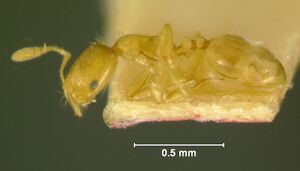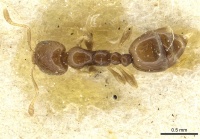Monomorium occidentale
| Monomorium occidentale | |
|---|---|

| |
| Scientific classification | |
| Kingdom: | Animalia |
| Phylum: | Arthropoda |
| Class: | Insecta |
| Order: | Hymenoptera |
| Family: | Formicidae |
| Subfamily: | Myrmicinae |
| Tribe: | Solenopsidini |
| Genus: | Monomorium |
| Species: | M. occidentale |
| Binomial name | |
| Monomorium occidentale Bernard, 1953 | |
Nothing is known about the biology of Monomorium occidentale.
Identification
Bolton (1987) - A member of the M. altinode complex in the M. monomorium species group. The form of the clypeus in occidentale is reminiscent of the Madeiran Monomorium carbonarium, but in the latter species the metanotal groove is broad and strongly cross-ribbed, the clypeal teeth are by no means as spectacularly developed, and the petiolar peduncle is relatively longer. The overall appearance of occidentale is that of a very specialized member of the altinode-complex, immediately isolated by the form of the clypeus and its teeth.
Keys including this Species
Distribution
Distribution based on Regional Taxon Lists
Afrotropical Region: Guinea (type locality), Sierra Leone.
Distribution based on AntMaps
Distribution based on AntWeb specimens
Check data from AntWeb
Countries Occupied
| Number of countries occupied by this species based on AntWiki Regional Taxon Lists. In general, fewer countries occupied indicates a narrower range, while more countries indicates a more widespread species. |

|
Estimated Abundance
| Relative abundance based on number of AntMaps records per species (this species within the purple bar). Fewer records (to the left) indicates a less abundant/encountered species while more records (to the right) indicates more abundant/encountered species. |

|
Biology
Castes
   
| |
| . | Owned by Museum of Comparative Zoology. |
Images from AntWeb
   
| |
| Lectotype of Monomorium occidentale. Worker. Specimen code casent0915410. Photographer Will Ericson, uploaded by California Academy of Sciences. | Owned by MNHN, Paris, France. |
Nomenclature
The following information is derived from Barry Bolton's Online Catalogue of the Ants of the World.
- occidentale. Monomorium (Monomorium) occidentale Bernard, 1953b: 236, fig. 10A-E (w.q.) GUINEA.
- Type-material: lectotype worker (by designation of Bolton, 1987: 404), 5 paralectotype workers, 1 paralectotype queen.
- Type-locality: lectotype Guinea: Ziéla Savano-To, 850 m. (Lamotte); paralectotypes with same data, coded F108, T125, T127, T128, T130.
- Type-depository: MNHN.
- Status as species: Ettershank, 1966: 91; Bolton, 1987: 404 (redescription); Bolton, 1995b: 265.
- Distribution: Guinea, Sierra Leone.
Unless otherwise noted the text for the remainder of this section is reported from the publication that includes the original description.
Description
Worker
Bolton (1987) - TL 1.8-2.1, HL 0.48-0.54, HW 0.38-0.44, CI 76-81, SL 0.32-0.36, SI 80-87, PW 0.26-0.30, AL 0.50-0.60 (10 measured).
Clypeal carinae distinct, divergent anteriorly and the space between the carinae transversely shallowly concave . Anterior clypeal margin characteristically shaped and isolating the species from all other Afrotropical members of the group, being equipped with a pair of elongate narrow anteriorly projecting teeth at the corners of the prominent median portion of the clypeus. The teeth are usually slightly curved towards the midline and the anterior clypeal margin between them is conspicuously concave. Maximum diameter of eye 0.20-0.23 x HW and with 5-7 ommatidia in the longest row. In full-face view the eyes in front of the midlength of the sides. Antennal scapes, when laid straight back from their insertions, failing to reach the occipital margin; the latter broad and shallowly concave. Promesonotum evenly shallowly convex in profile, sloping posteriorly to the narrow but distinctly indented metanotal groove. Metanotal cross-ribs short but conspicuous. Propodeal spiracle very large, dominating the side of the sclerite. Petiole in profile with a high narrow node and a small lobate anteroventral process on the short peduncle. Postpetiole with a vertical anterior face, not as high as the petiole and more broadly rounded above. All surfaces of head and body with numerous standing hairs, the promesonotum with 7 or more pairs and the propodeum usually with 5 pairs. Sculpture absent except for scattered minute hair-pits and metanotal cross-ribs. Some specimens with sculptured vestiges on the mesopleuron. Colour dark brown, the gaster tending to blackish brown in some.
Type Material
Bolton (1987) - Lectotype worker, Guinea: Ziela Savano-To, 850 m (Lamotte) (Musee National d'Histoire Naturelle) (here designated) [examined].
The above lectotype designation was rendered necessary by Bernard's inclusion of some workers referable to Monomorium invidium in the type-series of occidentale. Those referable to invidium were Bernard's 'cotypes' from NE. Nimba (Villiers). Bernard's 'types' bearing the numbers F108, T125 , T127 , T128, T130, and the female T125 are now designated paralectotypes of occidentale.
References
- Bernard, F. 1953b [1952]. La réserve naturelle intégrale du Mt Nimba. XI. Hyménoptères Formicidae. Mém. Inst. Fr. Afr. Noire 19: 165-270 (page 236, fig. 10 worker, queen described)
- Bolton, B. 1987. A review of the Solenopsis genus-group and revision of Afrotropical Monomorium Mayr (Hymenoptera: Formicidae). Bulletin of the British Museum (Natural History). Entomology. 54: 263-452.. (page 404, see also)
References based on Global Ant Biodiversity Informatics
- Bernard F. 1953. La réserve naturelle intégrale du Mt Nimba. XI. Hyménoptères Formicidae. Mémoires de l'Institut Français d'Afrique Noire 19: 165-270.
- Bolton B. 1987. A review of the Solenopsis genus-group and revision of Afrotropical Monomorium Mayr (Hymenoptera: Formicidae). Bulletin of the British Museum (Natural History). Entomology 54: 263-452.
- Kouakou L. M. M., K. Yeo, K. Ouattara, W. Dekoninck, T. Delsinne, and S. Konate. 2018. Investigating urban ant community (Hymenoptera: Formicidae) in port cities and in major towns along the border in Côte d’Ivoire: a rapid assessment to detect potential introduced invasive ant species. Journal of Animal and Plant Sciences 36(1): 5793-5811.
- Kouakou L. M. M., W. Dekoninck, M. Kone, T. Delsinne, K. Yeo, K. Ouattara, and S. Konate. 2018. Diversity and distribution of introduced and potentially invasive ant species from the three main ecoregions of Côte d’Ivoire (West Africa). Belgian Journal of Zoology 148 (1): 83–103.

